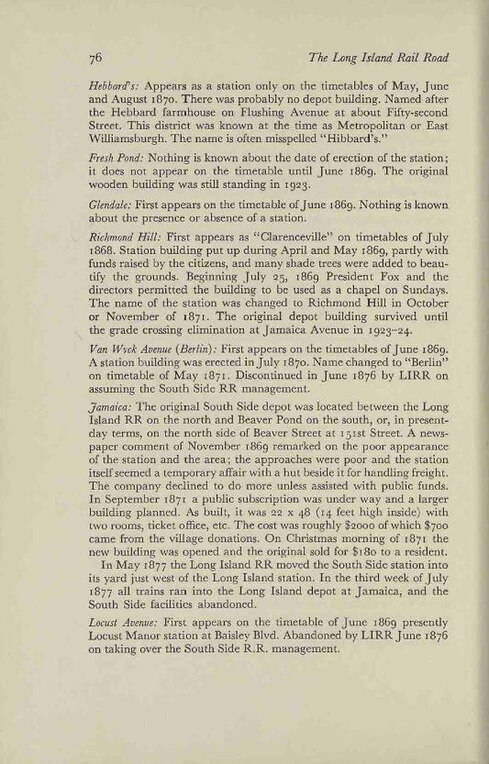Hebbard's: Appears as a station only on the timetables of May, June and August 1870. There was probably no depot building. Named after the Hebbard farmhouse on Flushing Avenue at about Fifty-second Street. This district was known at the time as Metropolitan or East Williamsburgh. The name is often misspelled "Hibbard's."
Fresh Pond: Nothing is known about the date of erection of the station; it does not appear on the timetable until June 1869. The original wooden building was still standing in 1923.
Glendale: First appears on the timetable of June 1869. Nothing is known about the presence or absence of a station.
Richmond Hill: First appears as "Clarenceville" on timetables of July 1868. Station building put up during April and May 1869, partly with funds raised by the citizens, and many shade trees were added to beautify the grounds. Beginning July 25, 1869 President Fox and the directors permitted the building to be used as a chapel on Sundays. The name of the station was changed to Richmond Hill in October or November of 1871. The original depot building survived until the grade crossing elimination at Jamaica Avenue in 1923–24.
Van Wyck Avenue {Berlin): First appears on the timetables of June 1869. A station building was erected in July 1870. Name changed to "Berlin" on timetable of May 1871. Discontinued in June 1876 by LIRR on assuming the South Side RR management.
Jamaica: The original South Side depot was located between the Long Island RR on the north and Beaver Pond on the south, or, in present-day terms, on the north side of Beaver Street at 151st Street. A newspaper comment of November 1869 remarked on the poor appearance of the station and the area; the approaches were poor and the station itself seemed a temporary affair with a hut beside it for handling freight. The company declined to do more unless assisted with public funds. In September 1871 a public subscription was under way and a larger building planned. As built, it was 22 × 48 (14 feet high inside) with two rooms, ticket office, etc. The cost was roughly $2000 of which $700 came from the village donations. On Christmas morning of 1871 the new building was opened and the original sold for $180 to a resident.
In May 1877 the Long Island RR moved the South Side station into its yard just west of the Long Island station. In the third week of July 1877 all trains ran into the Long Island depot at Jamaica, and the South Side facilities abandoned.
Locust Avenue: First appears on the timetable of June 1869 presently Locust Manor station at Baisley Blvd. Abandoned by LIRR June 1876 on taking over the South Side R.R. management.
